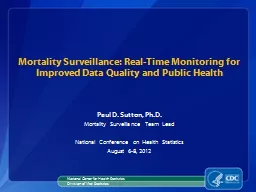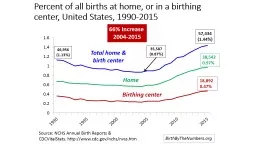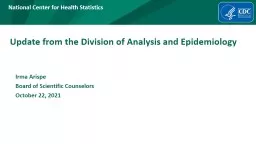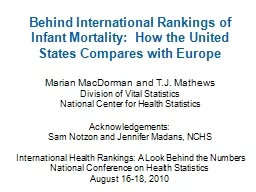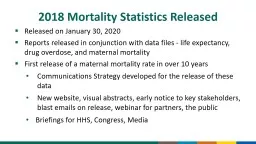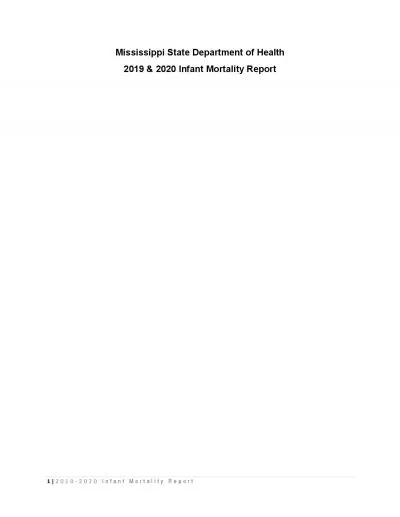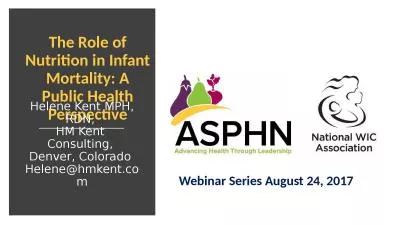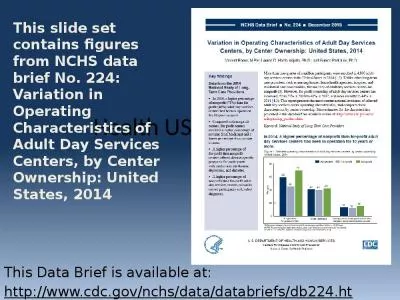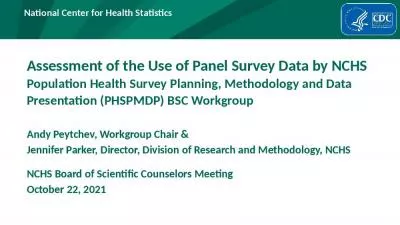PPT- Trends in Infant Mortality in the United States, 2005-2014. NCHS Data brief, No. 279,
Author : faustina-dinatale | Published Date : 2019-11-06
Trends in Infant Mortality in the United States 20052014 NCHS Data brief No 279 March 2017 Trends in Infant Mortality in the United States 20052014 NCHS Data brief
Presentation Embed Code
Download Presentation
Download Presentation The PPT/PDF document " Trends in Infant Mortality in the Un..." is the property of its rightful owner. Permission is granted to download and print the materials on this website for personal, non-commercial use only, and to display it on your personal computer provided you do not modify the materials and that you retain all copyright notices contained in the materials. By downloading content from our website, you accept the terms of this agreement.
Trends in Infant Mortality in the United States, 2005-2014. NCHS Data brief, No. 279,: Transcript
Trends in Infant Mortality in the United States 20052014 NCHS Data brief No 279 March 2017 Trends in Infant Mortality in the United States 20052014 NCHS Data brief No 279 March 2017. Ashley H. Schempf, PhD. Office of Epidemiology, Policy and Evaluation. Maternal and Child Health Bureau. Health Resources and Services Administration, DHHS. Outline. Basic epidemiology. Background. Data from 2004-2006 Period Linked Live Birth / Infant Death File. 9Plots279.1Shortversionofthischapter........................279.2Interpretingplot.earthgraphs......................279.2.1Nomenclature............................279.2.2TheModelSelectiongraph......... Paul D. Sutton, Ph.D.. Mortality Surveillance Team . Lead. National . Conference on Health Statistics. August 6-8, 2012. National Center for Health Statistics. Division of Vital Statistics . Mortality Surveillance. 1990-2015. Total home & . birth center. Home. . Birthing center. 46,956. (1.13%). 35,587. (0.87%). 57,434. (. 1.44%). 66. % . Increase . 2004-2015. 38,542. 0.97%. 18,892. 0.47%. BirthByTheNumbers.org. Statistics . Jane F. Gentleman. National Center for Health Statistics. Some common activities. . Vital statistics. Surveys/censuses of health care providers . (with CIHI). National health interview surveys:. TO THE GENERAL POPULATION IN MASSACHUSETTS. OLUSEYI ALEGE, CHELSEA AMOAKO, QUEENLY KYEI & LILI ZHAO. SHREWSBURY HIGH SCHOOL, WORCESTER TECHNICAL HIGH SCHOOL. What is Infant Mortality?. Infant Mortality. Trends in Infant Mortality in the United States, 2005-2014. NCHS Data brief, No. 279, March 2017. Trends in Infant Mortality in the United States, 2005-2014. NCHS Data brief, No. 279, March 2017. Irma Arispe. Board of Scientific Counselors. October 22, 2021 . NCHS Division of Analysis and Epidemiology. Major Program Areas. Goal 1: Expand Relevance, External Engagement. . Understand user needs. Marian MacDorman and T.J. Mathews. Division of Vital . Statistics. National Center for Health Statistics . Acknowledgements: . Sam Notzon and Jennifer Madans, NCHS. International Health Rankings: A Look Behind the Numbers . Released on January 30, 2020. Reports released in conjunction with data files - life expectancy, drug overdose, and maternal mortality. First release of a maternal mortality rate in over 10 years. Communications Strategy developed for the release of these data. Mississippi State Department of Health2019& 2020Infant Mortality Report Infant Mortality Report Table of ContentsAcknowledgmentsSuggested CitationExecutive SummaryBackgroundKey Findings Key Recommend Webinar Series August 24, 2017. . 2017. Helene Kent MPH, RDN, . HM Kent Consulting, . Denver, Colorado . Helene@hmkent.com. ASPHN is a nonprofit membership organization providing state and national leadership on food and nutrition policy, programs and services aimed at improving the health of our population. ASPHN membership is composed of nearly 300 public health nutritionists nationwide. Members receive key resources, professional development, and beneficial peer support. ASPHN promotes the value of public health nutritionists and highlights their initiatives through print, digital and social media. To . This Data Brief is available at:. http://www.cdc.gov/nchs/data/databriefs/db224.htm. . Selected . operating characteristics of adult day services centers, by center ownership: United States, 2014. 1. Population Health Survey Planning, Methodology and Data Presentation (PHSPMDP) BSC Workgroup. NCHS Board of Scientific Counselors Meeting. October 22, 2021 . Andy Peytchev, Workgroup Chair & . Jennifer Parker, Director, Division of Research and...
Download Document
Here is the link to download the presentation.
" Trends in Infant Mortality in the United States, 2005-2014. NCHS Data brief, No. 279,"The content belongs to its owner. You may download and print it for personal use, without modification, and keep all copyright notices. By downloading, you agree to these terms.
Related Documents



